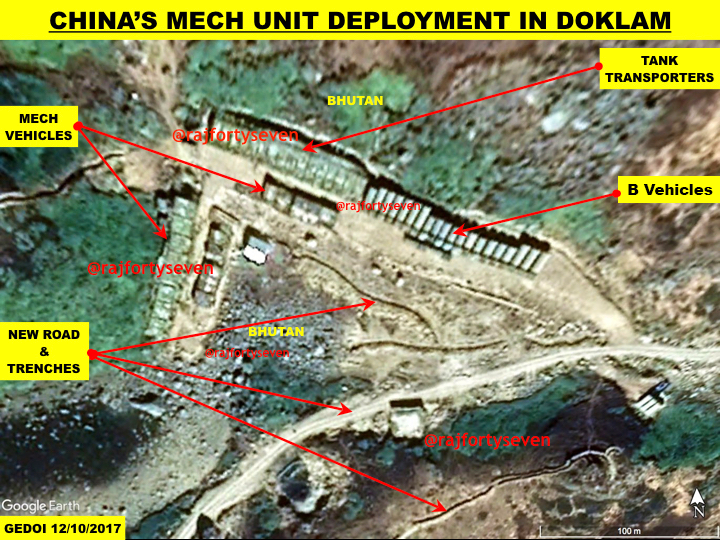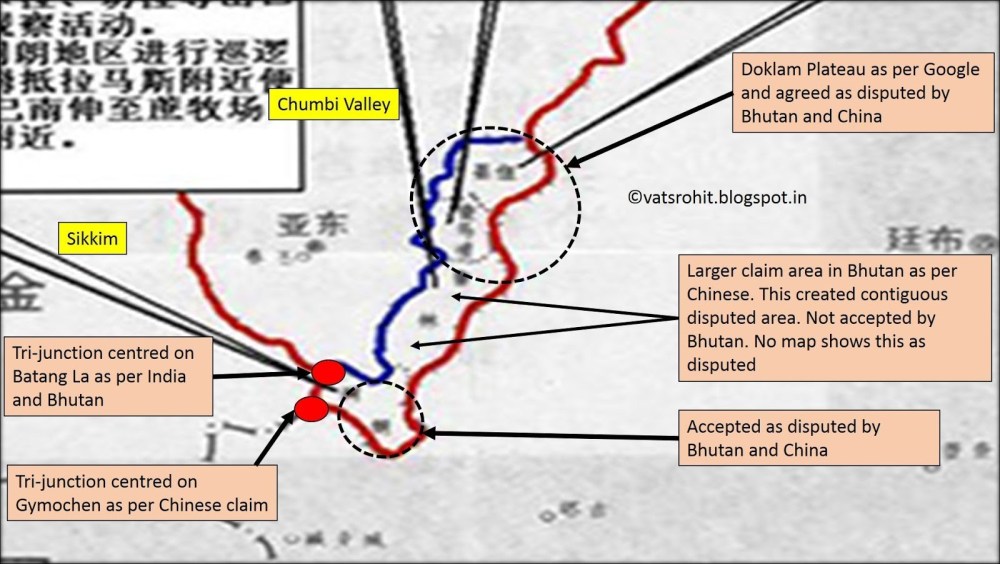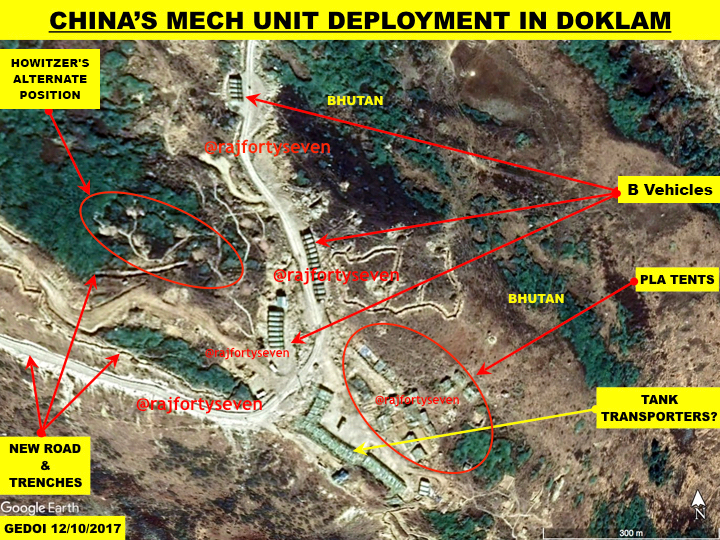New visuals show PLA deployment is close to last year’s face-off point and hasn’t thinned down as Indian Army chief Gen. Rawat claimed last week.
New Delhi: Almost five months after India and China agreed to end their tense military face-off in the Himalayan region of Doklam, Beijing has almost completely taken control of the northern side of the disputed plateau, latest satellite images accessed by ThePrint show.
The new images show concrete posts, seven helipads, new trenches and several dozen armoured vehicles close to the point where the Indian Army and the People’s Liberation Army (PLA) troops were locked in a 72-day confrontation last year.
The discovery comes days after Army chief General Bipin Rawat said that China continues to have troops in North Doklam but also added that the deployment had thinned down recently.
However, new satellite imagery accessed by ThePrint from 10 December 2017 shows that the Chinese side is now well entrenched in the area, with heavy road building machinery still present close to the stand-off point.
The face-off was triggered last June after Indian troops prevented Chinese workers backed by the PLA from completing a road that would have given them fast access to the south Doklam area. The Doklam plateau is contested between China and Bhutan, with India also having a strategic interest in keeping the area demilitarised.
These are first images that show the extent of the Chinese deployment at Doklam – and indicate a likely permanent PLA deployment, retaining the capability to construct the contested road at short notice.
Troop strength
The PLA has occupied almost every nook and corner, if not every inch, of the northern side of the plateau. Google Earth imagery clearly shows a large number of troops and equipment in semi-permanent structures under camouflage.
There is at least one complete mechanised regiment of possibly ZBL-09 IFVs or infantry fighting vehicles. There is also a strong possibility of another mechanised regiment under camouflage nets.
 Vinayak Bhat/ThePrint
Vinayak Bhat/ThePrint
Two major parking areas have been observed for tank transporters of smaller size, suggesting their use for mechanised vehicle transport. There are, in total, two regiments’ worth of tank transporters on the Doklam plateau.
There are more than a hundred large troop/equipment-carrying vehicles, or what the military calls ‘B-vehicles’.
At least four large bulldozers and four tippers have also been observed. This indicates a clear intention of pursuing the construction of the road beyond the contested point.
A large number of troops seem to have been kept in tents under very good camouflage, but certainly not good enough for satellite imagery not to spot them.
The observation tower
There is a very tall observation tower, at least two storeys high, constructed with cement concrete less than 10 metres from the most forward trench occupied by the Indian Army.
New trouble for India: China fully occupies Doklam, with armoured vehicles and 7 helipads
New Delhi: Almost five months after India and China agreed to end their tense military face-off in the Himalayan region of Doklam, Beijing has almost completely taken control of the northern side of the disputed plateau, latest satellite images accessed by ThePrint show.
The new images show concrete posts, seven helipads, new trenches and several dozen armoured vehicles close to the point where the Indian Army and the People’s Liberation Army (PLA) troops were locked in a 72-day confrontation last year.
The discovery comes days after Army chief General Bipin Rawat said that China continues to have troops in North Doklam but also added that the deployment had thinned down recently.
However, new satellite imagery accessed by ThePrint from 10 December 2017 shows that the Chinese side is now well entrenched in the area, with heavy road building machinery still present close to the stand-off point.
The face-off was triggered last June after Indian troops prevented Chinese workers backed by the PLA from completing a road that would have given them fast access to the south Doklam area. The Doklam plateau is contested between China and Bhutan, with India also having a strategic interest in keeping the area demilitarised.
These are first images that show the extent of the Chinese deployment at Doklam – and indicate a likely permanent PLA deployment, retaining the capability to construct the contested road at short notice.
Troop strength
The PLA has occupied almost every nook and corner, if not every inch, of the northern side of the plateau. Google Earth imagery clearly shows a large number of troops and equipment in semi-permanent structures under camouflage.
There is at least one complete mechanised regiment of possibly ZBL-09 IFVs or infantry fighting vehicles. There is also a strong possibility of another mechanised regiment under camouflage nets.

Two major parking areas have been observed for tank transporters of smaller size, suggesting their use for mechanised vehicle transport. There are, in total, two regiments’ worth of tank transporters on the Doklam plateau.
There are more than a hundred large troop/equipment-carrying vehicles, or what the military calls ‘B-vehicles’.
At least four large bulldozers and four tippers have also been observed. This indicates a clear intention of pursuing the construction of the road beyond the contested point.
A large number of troops seem to have been kept in tents under very good camouflage, but certainly not good enough for satellite imagery not to spot them.
The observation tower
There is a very tall observation tower, at least two storeys high, constructed with cement concrete less than 10 metres from the most forward trench occupied by the Indian Army.
New trouble for India: China fully occupies Doklam, with armoured vehicles and 7 helipads







